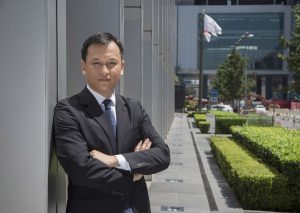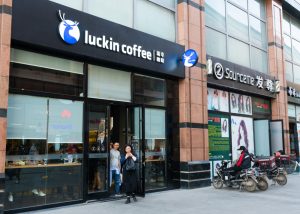Many may describe David Li as an acute serial investor. The company he helped found and invest in—Luckin Coffee—is arguably one of China’s greatest startup stories yet.
The fast-growing chain, which is based in Fujian Province’s Xiamen, was listed in the United States in May, only 18 months after it was established and even though it was still bleeding cash. Now, it’s a force to be reckoned with. It has grown into the country’s second-largest coffee chain with 3,000 stores as of mid-July. And it has made its ambition clear: Luckin wants to overtake Starbucks and become China’s market leader by the end of this year.
Li, who is in his 40s, was once the head of Warburg Pincus Asia Pacific, well-known for its portfolio of investments in CAR Inc, China’s largest car rental service provider, as well as home improvement and furnishings mall operator Red Star Macalline.
In 2017, Li founded Beijing-based Centurium Capital, which led Luckin’s series A and B financing rounds. As Luckin’s largest institutional investor, Centurium now holds an 11.9% stake in the coffee chain.

Li has taken part in every key decision in Luckin’s operations. In an interview with 36Kr, the entrepreneur shared his ideas about why Luckin isn’t just a run-of-the-mill coffee shop. People should take Luckin as a “data-driven” startup, he said, rebutting criticism that its business model isn’t sustainable.
Below is an edited excerpt of the interview.
Kr: The business model of Luckin is controversial. How did it attract your investment in the first place?
DL: Centurium Capital is the largest institutional investor in Luckin. We led the Series A and B rounds of financing. But my participation took place earlier than the fundraising stage. You can say that we are the founding members of the company.
It started in the second half of 2016. I discussed the idea of a coffee chain with Lu Zhengyao and Qian Zhiya. [Editor’s Note: Lu is chairman of Luckin, while Qian is CEO.] Later, we took the discussion to the next level, including every aspect of the business model, the marketing strategies, brand strategies, organization of the company, and a potential initial public offering.
What is important is that we formed a team of over 100 engineers within just one and a half years—we built the technology platform to lay the business’ foundation.
You can order by phone at any store, and all the information will appear on our platform. The whole supply chain of Luckin operates around it. The information decides the locations of our new stores, selection of products, and distribution channels. Many people don’t realize the essence: Luckin is actually a data-driven company.
Kr: Nowadays, almost every new retail company says they are data-driven. How is Luckin different?
DL: Data changes the structure of costs. It saves costs, and largely improves the efficiency.
One area where the use of data has given us an edge is the ability to reduce rental costs. While traditional food and beverages (F&B) outlets seek to open large storefronts at busy locations to attract more customers, we do not rely on extravagant designs or location advantages to increase foot traffic. Rather, because our customers order coffee via our app, we can direct customers to us. This allows us to pass on savings to them as we incur lower rental costs. On the other hand, we can also analyze the orders we receive to determine our store locations. We will open outlets at locations where heavy order volumes are observed to meet demand.
A second advantage of using data is the elimination of inefficiencies inherent in the conventional methods of managing F&B outlets. Store managers of our competitors are often overwhelmed in day-to-day operations like serving customers and taking orders, as well as managing inventory. This means each store operates as an independent business entity, as individual managers need to estimate customer demand and make the final call on how much inventory has to be ordered to avoid an under-supply or oversupply.
But Luckin has expunged that practice. Because of the centralization of business planning, decisions about store inventories are not made on-site. Our outlets merely act as “fulfillment centers” that each require just two to three employees whose sole duty is to focus on making a good cup of coffee. This has allowed us to improve the productivity of our on-location staff and achieve economies of scale by lowering manpower costs.
We are on track to open 4,500 outlets by the end of the year, a mere pipe dream for conventional players in the industry.

Kr: Some people have cast doubt on your cash-burning business model that gains customers by offering steep discounts, and said that you might be the next Ofo. What is your view on that? [Ofo is a bike–sharing company currently on the verge of bankruptcy after stiff competition. Its users could ride for as little as RMB 1 (USD 0.14) per hour after paying a 99-yuan deposit.]
DL: Luckin is not Ofo. People only saw one thing in common: subsidy offerings. But examine the logic: if we improve the efficiency of the supply chain, then we can reduce the overall costs. We give part of the savings back to the customers. In this case, we are similar to the US retailer Costco, which provides benefits to its members by controlling costs. Today, Luckin has 18 million paying members who order via our app and we possess all of their information. So these 18 million people are our members.
Let’s do the calculation. The cost of one cup of coffee by our competitor is RMB 21 or 22. That encompasses rental cost of RMB 10 or 11, labor cost of RMB 5 or 6, and raw material cost of RMB 4. Luckin’s raw material cost is similar to our competitors but our rental and operation costs are much lower. In general, our base cost for each cup of coffee is RMB 13. Theoretically, we can make money from the price gap. But now we want to focus on achieving economies of scale first.
Kr: Why are there only a few outside investors being introduced to Luckin? Does the company welcome new sources of capital?
DL: The more resources the better, that’s for sure. But we have different priorities at different stages. To obtain some resources, you may sacrifice time and efficiency. In the development of Luckin, we prefer time and efficiency at this stage.
Luckin is a ground-breaking model, and it’s common for people to have misunderstandings. But we made sure at the beginning that this company must develop at a fast pace, and that means there can’t be many debates. We look in the same direction and run toward our goal. At our IPO, we did bring in another investor—Starbucks’ [second largest] stakeholder BlackRock. We welcomed BlackRock, because it has sound judgment and aims for long-term returns.
Low De Wei contributed to this story.
The original article was written by Shimeng Gao for 36Kr, KrASIA’s parent company.
Contact the writer at [email protected]
